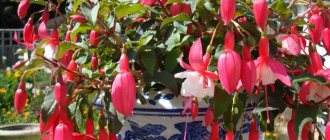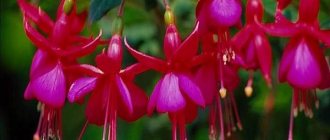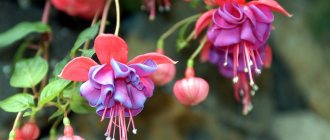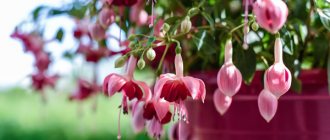Fuchsia has been known to flower lovers for over 200 years.
Common names: gypsy earrings, ballerina. In the southern regions it grows in gardens, in the northern regions it is cultivated as a houseplant.
Beautiful lantern-shaped flowers come in different colors. The corolla cups, pink, white, and red, that are curved upward at the edges, give them a special grace. Flower petals usually have a different color.
The flowers themselves can be simple, semi-double or double.
Breeders have developed many new varieties of fuchsia. It can be grown as an ampel plant, a standard tree or a lush bush.
Although fuchsia is considered an unpretentious flower, there are certain difficulties in caring for it. The most important nuance is to ensure a period of rest in winter.
Features of fuchsia
Under natural conditions, fuchsia grows in mountain crevices and forests.
Fuchsia is a small tree or shrub with flexible reddish shoots and small green leaves. In nature, this plant is found in America and New Zealand. A special feature of fuchsia is its flowers, consisting of a calyx and a corolla.
This plant is absolutely safe for children and pets. Its fruits are edible and can be added to various desserts.
This is an unpretentious plant that even an inexperienced gardener can grow. This indoor flower will not only decorate any interior, but will also help create a favorable aura in the house. According to superstitions, fuchsia helps develop intuition and gives inspiration to creative people.
The shades of purple in the palette are named after this plant.
The color of fuchsia is considered to be a purple hue. But in fact, it is a collective definition of several shades of purple: from pale crimson to deep violet.
Photo: interior use
Fuchsia will fit perfectly into the living room interior
You can also grow fuchsia as a hanging plant by hanging a flower pot on the terrace or balcony
Fuchsia will decorate the window sill in the kitchen
Description and botanical characteristics of fuchsia
In nature, Fúchsia is a bush, so in fact, depending on the variety, a houseplant can be given any shape thanks to shaping and pruning: ampelous, standard, spherical. Many varieties tolerate shearing well, others bushy, and some have stems that quickly become woody. In the wild, the height of the stems can reach incredible sizes.
We are talking about meters, sometimes 2-4 m. In pots, their sizes are much more modest: plants do not grow above a meter. The stem is flexible and long, covered with opposite oval-shaped leaves with pointed and jagged ends. The color of the leaves is rich green, sometimes with a reddish tint. Many varieties have hair on the leaves, veins and shoots. Photos of an exotic flower can partly convey its beauty, sophistication, perfection of shapes and play of colors.
Flowering is usually long and abundant. Depending on the number of petals, the degree of terry is determined: non-double varieties have 5 petals, semi-double varieties have 7, terry varieties have more than eight. The structure of a drooping flower is layered: a calyx with long blades and a tube attached to the peduncle; a corolla emerges from it, from which, in turn, very long stamens grow.
All this together looks like a doll or a ballerina: long legs, a skirt, arms. And the colors are also bright, like toys, and on one flower there are often 2-3 different shades. One of the shades of the color palette was even called “fuchsia”; artists or clothing creators usually use it in their terminology.
It will also be interesting: New Guinea balsam - care at home and in open ground?
Popular types and varieties with photos
There are about 100 species of this plant in nature. Most of them are suitable for growing at home. Breeders have also developed many different varieties, the flowers of which differ in shape and shade.
Graceful
In nature, graceful fuchsia can reach 3 meters in height, but in indoor conditions it is rarely higher than 1 m
This tall variety has beautiful large flowers. Fuchsia graceful blooms from spring to autumn.
Shining
Fuchsia radiant is a small shrub with purple flowers.
Fuchsia radiant, or shiny, is distinguished by purple-green leaves with pointed edges and crimson flowers with a crimson tint. With proper care, the plant will delight with lush and continuous flowering until the onset of cold weather.
Magellan
As a rule, Magellanic fuchsia flowers are collected in inflorescences
Fuchsia Magellanica is an evergreen shrub with large flowers, which can be single or collected in inflorescences of 4 pieces.
Blue Angel
Fuchsia Blue Angel looks especially impressive in wicker plant pots or elegant hanging baskets
One of the most popular forms of fuchsia is ampelous. The Blue Angel variety with double lilac flowers on snow-white sepals looks attractive in hanging flowerpots.
Combination of fuchsia with other colors
Fuchsia is combined with the same expressive tones as itself: be it red or green, the degree of brightness of the shade determines the main color. It often participates in thermal contrast and creates juicy pairs. She also has access to light contrast with dark tones. Next we will present a table: what colors do professionals combine it with? There are 10 palettes with 5 shades for you.
Color combination: fuchsia and pink is a combination of related shades that deepen it, giving it a lively shine and a play of chiaroscuro. For a couple, you can take royal pink, lilac pink, hot pink, red pink, crimson
The combination of fuchsia and red is a shocking tandem of related, bright tones: flashy, dramatic and at the same time bewitching with its strength and energy. Choose a pair of tones of scarlet, Chinese red, carmine, bright burgundy, and wine.
The combination of fuchsia and orange is one of the most popular in the last few years. In addition to the saturation of both shades, it also contains thermal contrast (orange, as the hottest tone of the entire color palette). Build a combination of peach, orange-coral, bright orange, fiery, red-orange.
Fuchsia goes with yellow Juicy, warm yellow shades give deep pink a summer, sunny look. This is both a contrast in warmth and lightness. Choose apricot, sunny yellow, corn, mustard, amber tones for the combination.
Fuchsia is combined with warm shades of green - forming a natural pair, imbued with summer and relaxation. The expressiveness of this combination is that the yellow-green tones are complementary to this shade of pink. Choose a pair of chartreuse, yellow-green, green, brown-green, dark green.
Fuchsia is combined with cool shades of green, resulting in an exotic palette of complex, rich and “expensive” colors. The range is reminiscent of a resort holiday. Combine it with tones of menthol, mint, kelly, emerald, malachite.
The color combination: fuchsia and blue is a bright warm-cold contrast. The main shade has a blue undertone, which makes this combination especially harmonious. In a pair, take soft blue, topaz, electric blue, Prussian blue, cobalt.
The combination of fuchsia and violet is built on the similarity of shades, where violet is built from red + blue, it can be considered as white + purple, which consists of red + blue. Combine it with blue-violet, lavender, purple, grape, eggplant.
The combination of fuchsia with brown is softer and more ordinary than with orange. It is he who tries to fight the obsession of the main tone, and only he manages to slightly dim it. Combine with oak, yellow-brown, bronze, tea, dark chocolate.
A combination of fuchsia with white, gray and black . You want to highlight such a catchy and attractive tone, and the best background for it would be neutral tones: white, gray, silver and black. They will support the cool undertone of the color and provide the necessary contrast. Choose a pair of creamy white, white-gray, steel, anthracite, blue black.
Planting: choosing a pot and soil
Nutritious, slightly acidic soil is suitable for growing fuchsia. The soil mixture can be prepared at home by mixing the following components:
- 3 parts leaf soil;
- 2 parts peat;
- 1 part sand.
Compo Sana brand universal soil is suitable for growing fuchsia.
The purchased flower can be grown in ready-made universal soil, which is sold in flower shops. When purchasing a soil mixture, you should pay attention to Rich Land and Compo Sana brand substrates.
A small clay pot with a hole for drainage is suitable for planting fuchsia.
The pot for planting fuchsia should be no more than 9 cm in diameter. It is advisable to plant the plant in a container made of ceramic or clay, since the growth and development of this indoor flower is adversely affected by overheating of the soil. A layer of expanded clay or small pebbles should be placed on the bottom of the selected pot, and then filled with soil mixture.
Sweater
A fuchsia sweater, jumper, cardigan will become an iconic part of your winter wardrobe. It's not just a millennial item, it's warm and comfortable in cold weather.
Table: conditions of detention depending on the season
| Season | Lighting | Optimal temperature conditions | Humidity | Accommodation |
| Spring, summer and autumn | The plant is a light-loving plant, but it must be protected from exposure to direct sunlight. | It is desirable that the temperature be within +18…22°C | The optimal humidity level is 50%. It is recommended to place wide containers of water near the flower or place the pot with the plant on a tray with wet pebbles. On hot days, the pet should be additionally sprayed with settled water in the mornings and evenings. | It is recommended to place the pot on an east or west windowsill. In summer it is better to take it out onto the balcony |
| Winter | It is advisable to provide fuchsia with 12-hour additional lighting using a fluorescent lamp | The room temperature should not rise above +18 °C | Spraying is not required in winter. Humidity should be maintained at the same level | It is advisable to move the pot to the basement. If the plant is left on the window sill in the room for the winter, then it needs to be moved away from heating appliances. |
Fuchsia indoor wintering. Preparing a houseplant for winter
From time to time it is important for every plant to rest. If the fuchsia is in a heated room, it is fed and watered as in summer, then the plant will not have the strength to bloom. In addition, the bush grows quickly and occupies a large area. Before wintering, you should examine how much the branches have grown.
In the first year of fuchsia growth, you should not overwinter with shoots that are too long. Therefore, they are cut short, leaving a length of about 15 centimeters. After the bush is formed, all weakened and diseased branches are cut off. You should not thicken the bush too much, otherwise it will not grow well. The plant should only have strong shoots left, the rest should be cut off, leaving 1/3 of the shoots.
You need to pay attention to semi-ampeloid forms. Their weak shoots break under the weight. Only strong branches are left on the bushes. To switch to winter mode, plants need to drop the temperature to +10 degrees. Therefore, fuchsias are put away in the basement or placed on a glazed balcony. In such a room, the temperature should not be below zero so that the indoor plant does not die.
If there is no cooler place, then you can simply choose a cold corner in the house. When the fuchsia continues to grow, fresh shoots are cut with scissors or pinched.
Before leaving the winter hut, all diseased parts of the plant are cut off and overgrown branches are removed. To make the crown more lush, it is recommended to pinch the tops of the shoots after growth begins. Flowering occurs no earlier than two months after the procedure. In order for the plant to actively produce buds in the summer, it is necessary to pinch it no later than April.
Home care
When growing and caring for fuchsia at home, it is necessary to regularly perform the following procedures:
- watering;
- fertilization;
- pruning and pinching;
- transfer.
Watering
In summer, it requires frequent and abundant watering. At this time of year, it is advisable to water the plant every 4 days. Excess liquid must be drained from the pan immediately. With the onset of autumn, the frequency of watering should be reduced to once a week. In winter, fuchsia should be watered no more than 2 times a month.
Fertilizer application
It is recommended to feed fuchsia with fertilizer for ornamental flowering plants
You need to fertilize once every 2 weeks. It is necessary to feed fuchsia with complex fertilizers for ornamental flowering plants. Liquid fertilizers should be applied after watering. During the dormant period that occurs in fuchsia in winter, the plant does not need to be fed.
After planting and for a month after transplanting, there is no need to apply fertilizer to a new pot.
Transfer
Fuchsia must be replanted every year into a pot that is 3 cm larger in size than the old one. The procedure is recommended to be carried out in the spring. Transplantation is carried out using the transshipment method. Step-by-step instructions for the procedure:
- Fill the new pot with a layer of drainage and soil mixture.
- Remove the fuchsia from the old container along with the earthen lump.
- Move the plant to a new container.
- Fill the voids on the sides with soil.
- Trim the plant stems by a third.
- Place the fuchsia in a place with diffused lighting.
- Spray the foliage and water the plant generously.
Trimming and pinching
Pruning is required 2 times a year. In autumn, you need to remove faded flowers and shorten the branches by 2 cm from the dormant buds. The second pruning should be done in winter, removing dry leaves and branches. You should also cut off all long shoots with disinfected garden shears.
By pinching, you can give the plant the desired shape. In addition, this procedure promotes abundant flowering. Hanging plants should be pinched through 2 internodes, and bush plants - through 3 internodes.
How to properly preserve fuchsia in winter. Fuchsia - we're sending it out for the winter
Old gardening books say that fuchsias and pelargoniums are not indoor plants, they are grown to decorate verandas and balconies in the summer, and indoors they only survive the winter because they do not tolerate frost.
What winter conditions are needed to maintain fuchsia?
Optimal conditions for fuchsias in winter are a bright, frost-free room, temperature +5...+15°C, the veranda of a country house is best suited.
Don't you have a greenhouse in your apartment? Don’t be upset: out of love for you, fuchsia can survive the winter on a window and at higher temperatures. You just need to take into account that she will be uncomfortable lying near or in a draft. And in frosty weather, do not leave plants directly under an open window. But if the flow of cold air does not hit them directly, then the lungs will only benefit them. A few hours of fresh air a day is enough. Of course, for heat-loving fuchsias - Bolivian and triphylla hybrids - the temperature should not fall below +15°C.
Is it possible to prune fuchsia in the fall?
If your fuchsia has grown greatly and it is difficult for you to maintain a one and a half meter plant at home, in August, cut off the young shoots from it above the woody part and. It is easier for small plants to find a bright, cool place for the winter. You can root cuttings annually for each new season or replace old plants with young ones every three years. Fuchsias take root easily, so getting new seedlings is not a problem. Cuttings of most varieties take root within two weeks in sand, perlite and even in water at a temperature of +15...+25°C. Anyone who has a lot of fuchsias and wants to preserve them all can be advised to cut the shoots of the plant short and put them in a box (each with a label), pour it out and put it in a frost-free attic or cellar.
Where can fuchsias winter outside?
Frost-resistant varieties in areas with mild winters (for example, south of Tambov) are not scary to leave in the garden. This kind of wintering is even better for them than in a warm apartment.
At the first frost, the plants are severely pruned, the fuchsias are removed from the hanging baskets and containers, the leaves and buds are removed, they are buried in the garden bed, etc. This can be done with cold-resistant varieties of fuchsia Magellan, for example, Whiteknight's Pearl, and some varieties of hybrid fuchsia: Gift Wrap, Glenby, Juni May, Multa, Welsh Dragon.
Reproduction methods
Fuchsia can be propagated in the following ways:
- cuttings;
- leaves;
- seeds.
The easiest way to propagate fuchsia is by cuttings
Most often, flower growers resort to cuttings, which are carried out in the spring. Step-by-step instructions for propagating fuchsia by cuttings:
- Cut several 15-centimeter cuttings from the mother plant (it is advisable to do this in early autumn).
- Remove the lower leaves from the shoots.
- Pack the cuttings in a bag of sawdust and place them on the bottom shelf of the refrigerator.
- With the onset of spring, remove the shoots from the refrigerator and treat them with a manganese solution.
- Place the cuttings in jars with filtered water.
- Cover them with polyethylene on top.
- Transplant the cuttings after 2 weeks into prepared pots with drainage and soil mixture.
If it is not possible to cut cuttings suitable for propagation from fuchsia, then the plant can be propagated by leaves. In this case, the procedure should be carried out as follows:
- Cut off a large leaf along with the cuttings.
- Bury the sheet 1 cm into moistened perlite.
- Cover the container with polyethylene.
- Carry out daily spraying.
- Separate the resulting rosette of leaves from the leaf as soon as it is strong enough.
- Plant the rosette in a separate container with soil mixture.
Propagation by seeds is carried out extremely rarely, since this method is complex and time-consuming.
Video: cuttings
Problems during cultivation
If the gardener does not care properly when growing this ornamental plant, the following problems may arise:
- Falling buds. In this case, you need to lower the temperature in the room, adjust the frequency of watering, feed the plant and provide it with sufficient lighting.
- Yellowing of foliage. This situation occurs when overwatering.
- Falling leaves. Dry indoor air, elevated temperatures and lack of fertilizers lead to this problem.
- Lack of flowering. In order for the plant to bloom at the right time, it must be pruned in a timely manner and provided with sufficient lighting. It is also recommended not to overfeed fuchsia with nitrogen fertilizers, as they negatively affect flowering.
- The appearance of dark spots on the leaves. In this case, it is recommended to reduce the humidity and ventilate the room.
Diseases and pests
Fuchsia can suffer from the following diseases and pests:
- Whitefly. Most often, fuchsia is attacked by these parasites and it is quite difficult for this ornamental plant to resist them. Folk remedies will not help get rid of them and you will need to use Angara for treatment. Before treating with this preparation, it is recommended to wash the plant with running water and laundry soap, covering the root system with a film so that the soap solution does not get on them.
- Spider mite. Fufanon will help get rid of parasites.
- Rust. In sick fuchsia, the affected leaves should be removed. Then you need to treat the plant with a soap solution.
- Root rot. The diseased plant must be removed from the pot, the roots washed and the rotten roots cut off. Then the fuchsia must be placed in a container with filtered water. When the plant has formed healthy roots, it can be transplanted into a new container with fresh soil.
Photo: symptoms of infection
Spider mites can be identified by the webs that appear on the undersides of leaves.
Whitefly larvae can be seen on the leaves of the plant
A sign of rust are brownish spots on the leaves of the plant.
With root rot, the roots of the plant begin to turn black.











